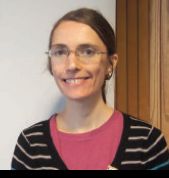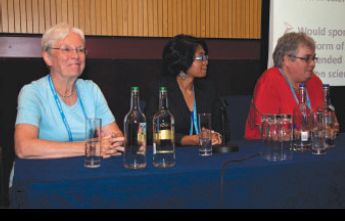
Physiology News Magazine
Women in Science at IUPS 2013
News and Views
Women in Science at IUPS 2013
News and Views
Caroline Wood
Volunteer at IUPS 2013
https://doi.org/10.36866/pn.92.12

Despite a greater number of women taking up scientific careers in recent decades, there is still a notable female absence within the upper tiers of research. The reasons behind this discrepancy, besides the more general challenges facing women in science, were discussed in a lively series of lunchtime sessions at the IUPS 2013 congress in Birmingham, UK, this July. Each talk was attended by over 100 delegates, the rooms humming with animated conversation. This was clearly not a ‘mother’s meeting’, however, due to the distinct undercurrent of seriousness as key concerns were brought forward. The sessions coincided with the launch of the IUPS booklet Women in Science, which carries profiles of distinguished female physiologists – copies of which were rapidly snapped up by delegates. The following are summaries of all three Women in Science sessions.
Session 1: Why mentoring and sponsorship works
Co-chair of the session Caroline McMillen, Vice Chancellor of the University of Newcastle, Australia, opened the debate by describing a Harvard Business Review survey of 4,000 business graduates which found that, over two years, the men achieved 15% more promotions despite the women receiving more mentorship. A key factor identified by the authors was that the males benefitted from more senior and influential mentors. The panel of speakers – including president of the Royal Swedish Academy of Sciences, Barbara Cannon – described how their careers had progressed thanks to (male and female) mentors who had taken an active interest in their development. Having an influential model prepared to speak up for them was a critical factor for each of these women’s careers. This suggests that young women researchers should be more strategic about their choice of mentor, factoring in their seniority and influence, as well as research interests.
A key message was that women need to seek recognition for their work and engage with the research community in order to get their ‘lucky break’. There was general agreement that greater funding opportunities to send young women researchers to conferences, as well as increased networking between senior scientists, could be an effective strategy. It was also suggested that women should make the effort to sit in on committee meetings or obtain panel positions; this can provide invaluable insight into ‘the gendered nature of leadership’ and how female candidates are perceived in interviews, compared with males. The structure of a committee panel, meanwhile, can influence the dynamics of an interview, and it was agreed that sponsors must be aware of these differences in order to train their mentees to modify their behaviour to communicate most effectively.
Concern was raised, however, that defined programmes of sponsorship may be detrimental. As Barbara Canon observed: “It is difficult to see how sponsorship could work if it is organised too much, because you have to believe in the person you are going to sponsor.” Individual sponsorship can give great individual benefits, as demon-strated by the panel, yet this is clearly insufficient. Although most institutes run mentorship schemes, sponsorship is distinct in that it stems from a personal belief in the candidate’s excellence. As Abigail Fowden, Professor of Perinatal Physiology at the University of Cambridge, said: “Sponsorship is something unique between sponsor and individual … the only way you are going to be sponsored is by being good at what you do.”
This sounds a call for female mentors to take a proactive role in promoting women candidates they genuinely believe to be excellent.

Session 2: Juggling Balls – family and physiology
The second session focused on the challenge of balancing active research with family commitments. A panel of six speakers, encompassing a wide range of career stages, family sizes and native cultures, gave their testimonies. It was clear that a combination of both personal resilience and external support had enabled these women to maintain distinguished scientific careers. Their examples illustrated how compromise can often begin right at the point of marriage: many had been obliged to disrupt their early careers by moving to where their husband could be most successful. On having children, some then had to struggle against an attitude that “if you can’t manage your children, you shouldn’t be in research”.
The panel and audience agreed that a supportive partner, willing to take their share of the juggling, was critical. In addition, some mothers had benefited from a culture with close family structures, allowing grandparents to carry part of the childcare burden. For those without this option, external provision – in the form of crèches, local schools and before/after school clubs – can decide whether a mother can remain in research.
Rafidah Hanim Mokhtar described how the Malaysian school system was tailored for working women, with the school day ending as mothers finished work. Kathy Morgan, of Boston University, emphasised how getting help and learning to multi-task were vital priorities, asserting that “You can’t hold down two full-time jobs, and research is a full-time job … if you compromise, you can’t compete.” Not everyone has the luxury of being able to delegate tasks to an administrative assistant, yet various strategies were discussed including encouraging teamwork and collaboration in the lab, not assigning projects to one person, establishing effective and flexible communication (such as email and Skype) and hosting regular lab meetings.
The session ended on a positive note, with the panel urging working mothers not to feel guilty, but rather to ensure that the time they spend with their children is of the highest quality. It was agreed that it needs to be possible for a woman to take a break from work to have a family, and that institutions can enable this by providing more part-time positions and childcare allowances. In this respect, a new initiative at Cambridge University is highly encouraging: a sum of money (£10-20,000) will be made available to every mother returning from maternity leave to fund whatever activity will most help in the transition back to work.
Session 3: What glass ceiling?
The final session explored the concept of the ‘glass ceiling’ as an invisible barrier against success, and the degree to which this applies to female researchers. Using her own progression as an example, Bridget Lumb asserted that this idea is not helpful for women, as it predisposes them to believe that obstructions are inevitable due to their gender, when, in reality, everybody comes across hurdles in their career. She described how her initial reluctance to apply for leadership positions changed with the realisation that men are encouraged to put themselves forward when they meet most of the job criteria, whereas women are put off by their weaknesses, even if they are just as capable. This idea is explored further in the book Beyond the Boy’s Club.
Dame Nancy Rothwell, President and Vice-Chancellor of the University of Manchester, discussed if there is a glass ceiling or ‘hurdles in the labyrinth’. She advised to “be true to your own strengths” and “listen to your head, but follow your heart.”
It was clear from the range of speakers and audience contributions that female researchers are more likely to progress if they are unaware of the ‘glass ceiling’, suggesting that this barrier is imposed in part by women themselves. This was illustrated by Ana Abdala, of the University of Bristol, who described a comprehensive study of research funding allocation commissioned by the EU. This found that women tended to apply for fewer grants and for smaller amounts of money, yet were just as successful (if not more so) as men in most European countries.
There was discussion around training women to demonstrate greater confidence in interviews. Having more females on funding panels was also identified as a future strategy for progress. Although things appear to be moving in the right direction, there is no room for complacency: as Ole Peterson summarised: “The glass ceiling is definitely not complete, it’s patchy. But it does exist.” The overriding message was that smashing the glass ceiling begins first in the woman scientist’s own mind.
Each session was imbued with a positive atmosphere, with many attendees stating that they had been ‘empowered’ by meeting women who had demonstrated that it is possible for females to have a successful research career. There was a feeling that, had the rooms not been booked for afternoon symposia, many attendees would have remained to network further and share experiences. There were considerable calls for similar sessions and a review of progress to be held at the 2017 conference in Rio de Janeiro. If the strategies discussed at IUPS 2013 are acted upon, there is every possibility that encouraging changes will have taken place by this time.
References
Doyle-Morris, S (2009). Beyond the Boys’ Club: Strategies for Achieving Career Success as a Woman Working in a Male-dominated Field. Wit & Wisdom Press.
The Gender Challenge in Research Funding: Assessing the European National Scenes. European Commission Directorate-General for Research, Science, Economy and Society. Available online at: http://www.snf.ch/SiteCollectionDocuments/Dossiers/dos_ gleichstellung_report_gender_challenge_research-funding_e.pdf [Accessed 7 August 2013]
